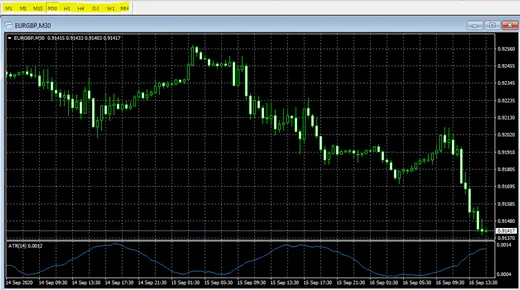Forex Time Frames - What Is It, Best Time Frame to Trade Forex

Table of Contents
- A guide to chart time-frames
- What is the best time frame to trade Forex?
- Trading lower forex time frames
- Trading higher forex time frames
- Selecting the best time frame for your strategy
- Conclusion
In this article, we will discuss the different chart time frames on your trading platform and how you can utilize them in your trading strategy. Using a combination of forex time frames to analyze is more likely to show successful results than using just one. There are many different combinations used by experts to identify the best possible analysis based on their trading goals and personality and we hope that this will help you to understand what might be the best time frame to trade forex according to your trading experience and goals.
A guide to chart time-frames
On every trading platform, you will notice the option to select the forex time frame of the chart. Simply put, the time frame you are looking at displays the price data over a different period of time.
For example, on a 1-minute chart, each candle (or bar) represents 1 minute of price data. On an hourly chart, each bar represents 1 hour of data and so on. Therefore, it makes sense to use the best time frames relevant to the duration and frequency of your trades.
Most platforms will offer at least 8 standard time frames as default: 1Min, 5Min, 15Min, 30Min, 1Hour, 4Hour, Daily, Weekly & Monthly.

Other platforms such as cTrader, MT5 & the FxPro Platform provide more forex trading time frames as default, and when using desktop-based platforms, you can also use 3rd party indicators to create unique time frames, or create 'Renko' charts, which builds brick candles based on price only, rather than time.
For more information about how candles are formed, please refer to our useful article on Japanese Candlesticks.
What is the best time frame to trade Forex?
While some traders may stick with one specific time frame, most successful traders will tell you that it is better to use a combination of forex time frames, to confirm your observations.
For example, a trader may notice a specific bullish candlestick pattern forming, alongside a buy signal from an indicator on the 15min chart. However, the 1hour chart of the same instrument may not give the same signal. On the other hand, it may strengthen your forecast.
A trend forming on a particular time frame may not correlate to the overall trend in a later time frame, and this is where your personal trading strategy comes in to assess the best time frame to trade forex. You need to identify which are useful to you and which are not, as a common mistake novice traders make is trying to use too many and becoming overloaded with conflicting signals which can lead to confusion or overtrading.
Trading lower forex time frames
Major FX pairs that are highly liquid and susceptible to economic data releases, tend to have more movement throughout the day, allowing traders to take advantage of short-term moves on lower forex trading time frames.
The peak time to trade intraday is through 1-4 pm GMT, as this is when the US and UK market sessions overlap so many traders will time forex trading during this period.
Trading lower time frames require fast reaction times and therefore it is only advisable to trade these if you have the time for trading during the day and can manage your positions.
it is not advisable to trade on a 1minute chart if you are a novice trader, as split-second movements can easily take you out of the market. You should also consider that placing several trades throughout the day means you will incur more trading costs (spreads and/or commissions).
Note: The FxPro daily technical analysis emails from trading central, provide intraday analysis using 30min Forex trading time frames.
Trading higher forex time frames
Whilst intra-day traders will typically look at lower time frames (under 1hour), those who trade long-term will be more interested in the bigger picture and utilise longer-term time frames such as daily or weekly for their analysis.
For example, if a trader decides to buy GBPUSD, with the opinion that the British Sterling will strengthen after Brexit, the trader is not going to be overly interested in the daily fluctuations and short term moves of the pair, unless it is going to impact the longer-term price trend. A reaction to BoE data let's say, which causes an immediate large whipsaw movement on the lower charts (where price spikes up and then swiftly reverses in the opposite direction), will not have much of an effect on the daily and higher charts unless the move was extremely significant.
Of course, long term traders need patience. Indicators will react slower on higher time frame charts and there will be far fewer signals given by analysis. You also need to ensure you have enough funds available to support position in the long run and consider that overnight swaps/rollovers will apply.
If you are limited on the amount of time and attention to spend in front of charts, long-term trading would be a better option for you.
Selecting the best time frame for your strategy
Intraday trading involves actively buying or selling a financial instrument within the same day. Such traders will usually not leave trades open overnight. The best day trading time frames are the 1-hour chart, the 15-minute and 5-minute chart combination. Typically, the 1-hour chart will be used to identify a trend, and the 15-minute chart is ideal for finding major support and resistance levels. The 5-minute chart is then used to narrow down the data and more accurately place your trade. Whilst these three-time frames are seen as the best combination for day trading, slightly different combinations may work better for you. Novice traders should be careful not to overtrade when day trading.
Swing trading a strategy in which an asset is held for a day or more, in an attempt to benefit from price changes (swings). Traders using this strategy will commonly work with the 4 Hour and Daily charts. The advantages are that the 4-hour chart is ideal for some momentum indicators such as the RSI to show divergences and identify trend changes. The daily chart is used to better understand overall price action.
The trading strategy of 'scalping' which is defined as taking several small, short term trades, works best with the lowest time frames such as 1 minute, and some may even use tick charts which formulate the chart based on a specific number of tick changes rather than time.
Some technical indicators will also work better on certain time frames compared to others, depending on their formulas. For example, when selecting a time frame for oscillators, they tend to work best with shorter periods. On the other hand, trend indicators tend to work better with a longer period.
So, according to the strategy you use and the forex pair(s) you wish to trade, you can determine the optimal set of time frames for your analysis.
Conclusion
In conclusion, there is no right or wrong answer to what exact time frames to use for trading. It is very subjective depending on your own trading style and preferences. However, some key points to consider are:
- Intraday traders usually use chart time frames from 5minutes-1hour
- It is advisable to use a combination of time frames to confirm observations
- Lower time frames will give frequent signals and require faster reaction times
- Higher time frames take longer to produce signals
- Novice traders may do better to start with a higher time frame and gradually reduce it although others will say you will learn faster starting with a lower one
Base your trading time frame around how long you want to be exposed for and how much time you can dedicate to monitoring and managing open positions. Use a FxPro demo account to practice and see what time frame works best for you.




